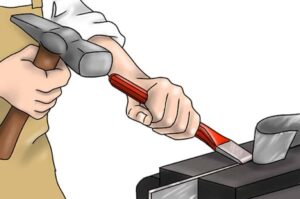Cold chiseling is a valuable technique for working with hard materials like stone, concrete, brick, and even metal. In this comprehensive guide, we’ll explore the fundamentals of cold chiseling, essential tools and materials, the step-by-step process, advantages, best practices, and safety precautions to help you master this skill.
Demystifying Cold Chiseling:
Cold chiseling is a precise process used to break down tough materials. It involves using a specialized tool called a cold chisel, which has a sharpened end for cutting through hard surfaces. These chisels are typically made from high-carbon or tool steel for durability.

Essential Tools and Materials:
- High-quality cold chisel.
- Depending on the material and force required, an electric grinder or a handheld hammer drill.
- Protective gear: safety glasses, work gloves, dust mask, and knee pads for safety.
The Step-by-Step Cold Chiseling Process:
- Select the work area and position the chisel at a 30-45 degree angle.
- Apply short, controlled bursts of pressure to the chisel. Avoid excessive force to prevent unexpected cracks.
- Keep your hands away from the immediate work area for safety.
- Use an electric grinder or hammer drill to refine edges and hard-to-reach spots after removing material.
Advantages of Cold Chiseling:
- Precision and accuracy for intricate designs.
- Minimal energy compared to hammering.
- Superior control over the final shape.
- No heat generation or release of volatile particles.
Best Practices for Success:
- Always wear protective gear.
- Choose a high-quality, sharp chisel.
- Position yourself for control and safety.
- Use short bursts of pressure.
- Regularly inspect and maintain tools.
- In confined spaces, consider using long-handled pliers for added control.
Also read – Top 10 On Going Mega Projects In World
Safety Precautions:
- Keep hands clear of the work area.
- Inspect tools before and after each project.
- Exercise caution and maintain awareness when using power tools.
- Wear protective gear indoors as well.
- Opt for long-handled pliers in tight spaces for better control.
In Conclusion:
Mastering cold chiseling can enhance your DIY projects involving hard materials. By following these guidelines, best practices, and safety measures, you can confidently create stunning surfaces while minimizing risks. So, grab your cold chisel and embark on your journey to become a skilled cold chiseling craftsman.
